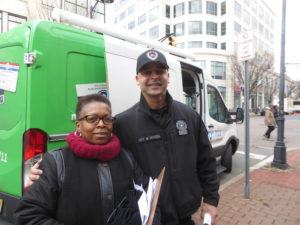By Jared Kofsky

In our last issue, we brought you the story of Morgan Wilson, a lifelong Mercer County resident who reunited with his long-lost son outside of the Rescue Mission of Trenton. In the time since the story was written, much has changed. Here is Part II of The Streetlight’s exclusive series, Morgan and Morgan.
“The bond that we have is incredible. I just wish he wasn’t so far away.”
That was how Trenton Area Soup Kitchen patron and lifelong Mercer County resident Morgan Wilson described his relation- ship with his son Morgan West Jackson in an interview with The Streetlight last spring.
After being seperated for 24 years, Wilson and West Jackson reunited after running into each other outside of the Rescue Mission of Trenton. When both men realized that they shared the same first name, they engaged each other in conversation.
“I listened to his story that day and I realized that this was my son,” Wilson explained.
Sure enough, through the assistance of Rose Bernard, his case manager at Oaks Integrated Care, Wilson confirmed that West Jackson was his long lost son, the man he had long hoped to see again following a period of incarceration.
Wilson, West Jackson, and Bernard were not the only people excited about the reunion. Word soon spread throughout Oaks Integrated Care’s Trenton-area offices and eventually to West Jackson’s adoptive brother, Darby, Pennsylvania firefighter Eric West Jackson. His brother told The Streetlight that he was very pleased that West Jackson reunited with his father after so many years apart.
Although the father and son saw each other for the first time in over two decades in New Jersey’s capital city, West Jackson was raised in suburban Philadelphia and later lived in New York and Scranton, Pennsylvania.
Despite being seperated by over 140 miles, Wilson and West Jackson continued to communicate frequently over the phone and over the internet. West Jackson signed his father up for Facebook, and the two strived to stay in contact for the next two years, hoping to regularly see each other in person as frequently as possible.
Now, the two Morgans no longer have to wonder when they will be near each other once again.
In late 2017, West Jackson returned to the city of his birth to live near his father for the first time in 26 years. In addition to residing near each other, both Wilson and West Jackson’s living conditions continue to improve.
Wilson recently passed his driver’s test and received his license. He also moved out of transitional housing and is now renting his own apartment in the suburbs, where he lives with his girlfriend and four-year-old son. Meanwhile, West Jackson is now employed locally and sees his father on a regular basis.
Both Wilson and West Jackson have been through quite a journey since West Jackson was born in the early 1990s, with both men experiencing different kinds of successes and failures.
From Wilson’s experiences in transitional housing to West Jackson’s frequent relocations for employment across the Northeast to their surprise reunion encounter outside of a local shelter, their experiences have each been quite memorable, resulting in plenty of stories for them to share with each other.
Clearly, after a quarter century apart, Morgan and Morgan are grateful to be together in Trenton once again.






